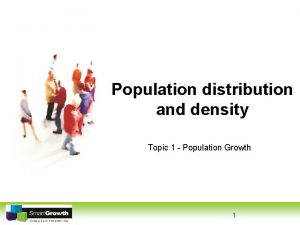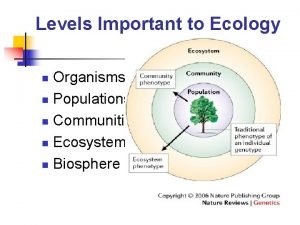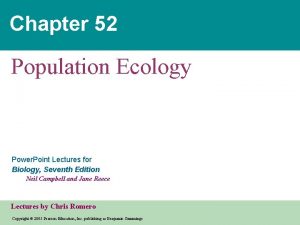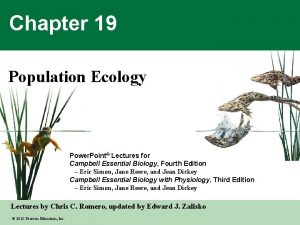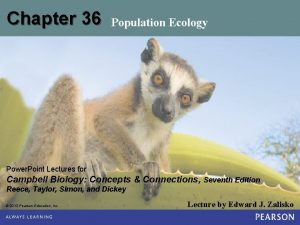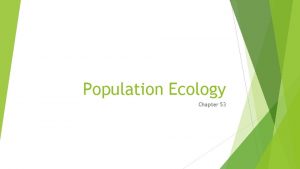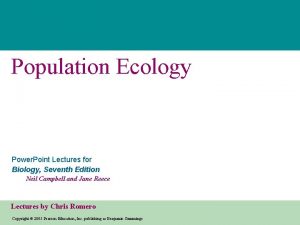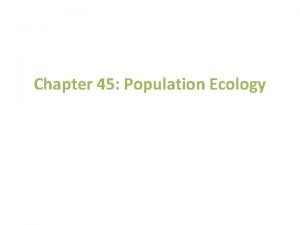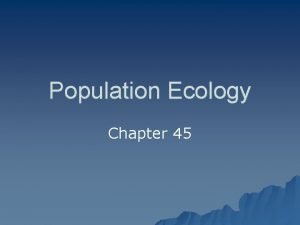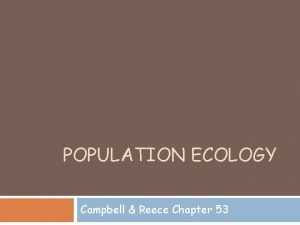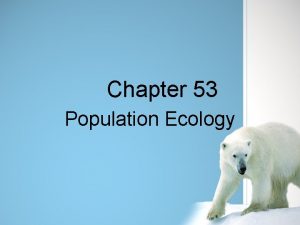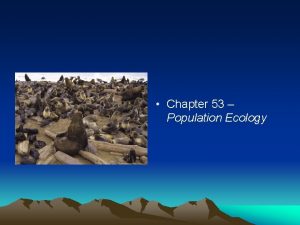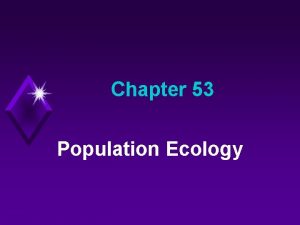Chapter 52 Population Ecology Power Point Lectures for














































- Slides: 46

Chapter 52 Population Ecology Power. Point Lectures for Biology, Seventh Edition Neil Campbell and Jane Reece Lectures by Chris Romero Copyright © 2005 Pearson Education, Inc. publishing as Benjamin Cummings

• Population ecology is the study of populations in relation to environment, including environmental influences on density and distribution, age structure, and population size Copyright © 2005 Pearson Education, Inc. publishing as Benjamin Cummings

Concept 52. 1: Dynamic biological processes influence population density, dispersion, and demography • A population is a group of individuals of a single species living in the same general area Copyright © 2005 Pearson Education, Inc. publishing as Benjamin Cummings

Density and Dispersion • Density is the number of individuals per unit area or volume • Dispersion is the pattern of spacing among individuals within the boundaries of the population Copyright © 2005 Pearson Education, Inc. publishing as Benjamin Cummings

LE 52 -2 Births Immigration Population Dynamics Population size Emigration Deaths

• In a clumped dispersion, individuals aggregate in patches • A clumped dispersion may be influenced by resource availability and behavior Video: Flapping Geese (clumped) Copyright © 2005 Pearson Education, Inc. publishing as Benjamin Cummings

LE 52 -3 a Clumped. For many animals, such as these wolves, living in groups increases the effectiveness of hunting, spreads the work of protecting and caring for young, and helps exclude other individuals from their territory.

• A uniform dispersion is one in which individuals are evenly distributed • It may be influenced by social interactions such as territoriality Video: Albatross Courtship (uniform) Copyright © 2005 Pearson Education, Inc. publishing as Benjamin Cummings

LE 52 -3 b Uniform. Birds nesting on small islands, such as these king penguins on South Georgia Island in the South Atlantic Ocean, often exhibit uniform spacing, maintained by aggressive interactions between neighbors.

• In a random dispersion, the position of each individual is independent of other individuals Video: Prokaryotic Flagella (Salmonella typhimurium) (random) Copyright © 2005 Pearson Education, Inc. publishing as Benjamin Cummings

LE 52 -3 c Random. Dandelions grow from windblown seeds that land at random and later germinate.

Demography • Demography is the study of the vital statistics of a population and how they change over time • Death rates and birth rates are of particular interest to demographers Copyright © 2005 Pearson Education, Inc. publishing as Benjamin Cummings

Life Tables • A life table is an age-specific summary of the survival pattern of a population Copyright © 2005 Pearson Education, Inc. publishing as Benjamin Cummings

Survivorship Curves • A survivorship curve is a graphic way of representing the data in a life table • The survivorship curve for Belding’s ground squirrels shows a relatively constant death rate Copyright © 2005 Pearson Education, Inc. publishing as Benjamin Cummings

LE 52 -4 Number of survivors (log scale) 1, 000 100 Females 10 1 Males 0 2 4 6 Age (years) 8 10

Number of survivors (log scale) • Survivorship curves can be classified into three general types: Type I, Type II, and Type III 1, 000 I 100 II 10 III 1 50 0 Percentage of maximum life span Copyright © 2005 Pearson Education, Inc. publishing as Benjamin Cummings 100

Reproductive Rates • A reproductive table, or fertility schedule, is an agespecific summary of the reproductive rates in a population • It describes reproductive patterns of a population Copyright © 2005 Pearson Education, Inc. publishing as Benjamin Cummings

Per Capita Rate of Increase • If immigration and emigration are ignored, a population’s growth rate (per capita increase) equals birth rate minus death rate • Birth – Death = growth rate • Zero population growth occurs when the birth rate equals the death rate Copyright © 2005 Pearson Education, Inc. publishing as Benjamin Cummings

Exponential Growth • Exponential population growth is population increase under idealized conditions • Under these conditions, the rate of reproduction is at its maximum, called the intrinsic rate of increase Copyright © 2005 Pearson Education, Inc. publishing as Benjamin Cummings

• Exponential population growth results in a Jshaped curve 2, 000 Population size (N) d. N = 1. 0 N dt 1, 500 d. N = 0. 5 N dt 1, 000 500 0 0 5 10 Number of generations Copyright © 2005 Pearson Education, Inc. publishing as Benjamin Cummings 15

LE 52 -10 Elephant population 8, 000 6, 000 4, 000 2, 000 0 1900 1920 1940 1960 1980 Year The J-shaped curve of exponential growth characterizes some rebounding populations

Concept 52. 4: The logistic growth model includes the concept of carrying capacity • Exponential growth cannot be sustained for long in any population • A more realistic population model limits growth by incorporating carrying capacity • Carrying capacity (K) is the maximum population size the environment can support Copyright © 2005 Pearson Education, Inc. publishing as Benjamin Cummings

LE 52 -11 Per capita rate of increase (r) Maximum Positive N=K 0 Negative Population size (N)

• The logistic model of population growth produces a sigmoid (S-shaped) curve 2, 000 Population size (N) d. N dt = 1. 0 N 1, 500 Exponential growth K = 1, 500 Logistic growth 1, 000 d. N dt = 1. 0 N 1, 500 – N 1, 500 0 0 10 5 Number of generations Copyright © 2005 Pearson Education, Inc. publishing as Benjamin Cummings 15

Number of Paramecium/m. L LE 52 -13 a 1, 000 800 600 400 200 0 0 5 10 15 Time (days) A Paramecium population in the lab

Number of Daphnia/50 m. L • Some populations overshoot K before settling down to a relatively stable density 180 150 120 90 60 30 0 0 20 40 60 80 100 120 140 160 Time (days) A Daphnia population in the lab Copyright © 2005 Pearson Education, Inc. publishing as Benjamin Cummings

LE 52 -13 c Number of females 80 60 40 20 0 1975 1980 1985 1990 1995 2000 Time (years) A song sparrow population in its natural habitat

The Logistic Model and Life Histories • Life history traits favored by natural selection may vary: • K-selection, or density-dependent selection, selects for life history traits that are sensitive to population density • r-selection, or density-independent selection, selects for life history traits that maximize reproduction Copyright © 2005 Pearson Education, Inc. publishing as Benjamin Cummings

Concept 52. 5: Populations are regulated by a complex interaction of biotic and abiotic influences • There are two general questions about regulation of population growth: – What environmental factors stop a population from growing? – Why do some populations show radical fluctuations in size over time, while others remain stable? Copyright © 2005 Pearson Education, Inc. publishing as Benjamin Cummings

Population Change and Population Density • In density-independent populations, birth rate and death rate do not change with population density • In density-dependent populations, birth rates fall and death rates rise with population density Copyright © 2005 Pearson Education, Inc. publishing as Benjamin Cummings

Birth or death rate per capita LE 52 -14 Density-dependent birth rate Densitydependent death rate Equilibrium density Population density Densityindependent birth rate Density-dependent death rate Equilibrium density Population density Densityindependent death rate

4. 0 10, 000 100 Average clutch size Average number of seeds per reproducing individual (log scale) LE 52 -15 3. 8 3. 6 3. 4 3. 2 3. 0 2. 8 100 10 1 Plants per m 2 (log scale) Plantain. The number of seeds produced by plantain (Plantago major) decreases as density increases. 0 10 40 50 60 70 Females per unit area 20 30 80 Song sparrow. Clutch size in the song sparrow on Mandarte Island, British Columbia, decreases as density increases and food is in short supply.

Territoriality • In many vertebrates and some invertebrates, territoriality may limit density Copyright © 2005 Pearson Education, Inc. publishing as Benjamin Cummings

• Oceanic birds exhibit territoriality in nesting behavior Copyright © 2005 Pearson Education, Inc. publishing as Benjamin Cummings

Other Factors • Health • Predation • Toxic Wastes Copyright © 2005 Pearson Education, Inc. publishing as Benjamin Cummings

• Many populations undergo boom-and-bust cycles • Boom-and-bust cycles are influenced by complex interactions between biotic and abiotic factors Copyright © 2005 Pearson Education, Inc. publishing as Benjamin Cummings

Hare population size (thousands) 160 120 0 Lynx 1850 1875 1900 Year 9 80 6 40 3 1925 0 Lynx population size (thousands) LE 52 -21 Snowshoe hare

The Global Human Population 6 5 4 3 2 The Plague 1 4000 3000 2000 8000 Copyright © 2005 Pearson Education, Inc. publishing as Benjamin Cummings B. C. 1000 B. C. 0 1000 A. D. 0 2000 A. D. Human population (billions) • The human population increased relatively slowly until about 1650 and then began to grow exponentially

LE 52 -23 2. 2 Annual percent increase 2 1. 8 1. 6 2003 1. 4 1. 2 1 0. 8 0. 6 0. 4 0. 2 0 1950 1975 2000 Year 2025 2050

Regional Patterns of Population Change • To maintain population stability, a regional human population can exist in one of two configurations: – Zero population growth = High birth rate – High death rate – Zero population growth = Low birth rate – Low death rate • The demographic transition is the move from the first state toward the second state Copyright © 2005 Pearson Education, Inc. publishing as Benjamin Cummings

LE 52 -24 Birth or death rate per 1, 000 people 50 40 30 20 10 Sweden Birth rate 0 1750 Mexico Birth rate Death rate 1800 Death rate 1850 1900 Year 1950 2000 2050

Age Structure • One important demographic factor in present and future growth trends is a country’s age structure • Age structure is the relative number of individuals at each age • It is commonly represented in pyramids Copyright © 2005 Pearson Education, Inc. publishing as Benjamin Cummings

LE 52 -25 Rapid growth Afghanistan Male Female Slow growth United States Male Female Age 85+ 80– 84 75– 79 70– 74 65– 69 60– 64 55– 59 50– 54 45– 49 40– 44 35– 39 30– 34 25– 29 20– 24 15– 19 10– 14 5– 9 0– 4 8 6 4 2 0 2 4 6 Percent of population 8 Decrease Italy Male Female 85+ 80– 84 75– 79 70– 74 65– 69 60– 64 55– 59 50– 54 45– 49 40– 44 35– 39 30– 34 25– 29 20– 24 15– 19 10– 14 5– 9 0– 4 8 6 4 2 0 2 4 6 Percent of population 8

LE 52 -26 80 50 Life expectancy (years) Infant mortality (deaths per 1, 000 births) 60 40 30 20 60 40 20 10 0 0 Developed countries Developing countries

Ecological Footprint • The ecological footprint concept summarizes the aggregate land water area needed to sustain the people of a nation • It is one measure of how close we are to the carrying capacity of Earth • Countries vary greatly in footprint size and available ecological capacity Copyright © 2005 Pearson Education, Inc. publishing as Benjamin Cummings

Ecological footprint (ha person) LE 52 -27 16 14 12 New Zealand 10 USA Germany Netherlands Japan Norway 8 6 UK Spain 4 World China India 2 0 Australia Canada Sweden 0 2 6 4 10 12 8 Available ecological capacity (ha person) 14 16
 Population ecology section 1 population dynamics answer key
Population ecology section 1 population dynamics answer key Study guide section 1 population dynamics
Study guide section 1 population dynamics Section 1 population dynamics answer key
Section 1 population dynamics answer key Population ecology section 1 population dynamics
Population ecology section 1 population dynamics Chapter 53 population ecology
Chapter 53 population ecology Equilibrial life history
Equilibrial life history Ecology
Ecology Chapter 53 population ecology
Chapter 53 population ecology Section 1 population dynamics answer key
Section 1 population dynamics answer key Chapter 53 population ecology
Chapter 53 population ecology Power system lectures
Power system lectures Logistic growth ecology definition
Logistic growth ecology definition Define exponential population growth
Define exponential population growth 52
52 Ecosystem vs community
Ecosystem vs community Concept 3 population ecology
Concept 3 population ecology Survivorship curve def
Survivorship curve def Characteristics of population ecology
Characteristics of population ecology Population characteristics ecology
Population characteristics ecology What is population ecology
What is population ecology Population definition ecology
Population definition ecology Population ecology
Population ecology Parasitism
Parasitism Power triangle diagram
Power triangle diagram Power bi training powerpoint
Power bi training powerpoint Point point power
Point point power Rick trebino
Rick trebino Neonatology lectures
Neonatology lectures Data mining lectures
Data mining lectures Advanced medicinal chemistry
Advanced medicinal chemistry Uva orthopaedics
Uva orthopaedics Ludic space
Ludic space Step wise project planning
Step wise project planning Cell and molecular biology lectures
Cell and molecular biology lectures Radio astronomy lectures
Radio astronomy lectures Dr sohail lectures
Dr sohail lectures Utilities and energy lectures
Utilities and energy lectures Web engineering lectures ppt
Web engineering lectures ppt How to get the most out of lectures
How to get the most out of lectures Frcr physics lectures
Frcr physics lectures Heel effect
Heel effect Cs106b lectures
Cs106b lectures Blood physiology guyton
Blood physiology guyton Aerodynamics lectures
Aerodynamics lectures Tamara berg husband
Tamara berg husband Theory of translation lectures
Theory of translation lectures Theory of translation lectures
Theory of translation lectures





















